Sports
Record breaker Summa
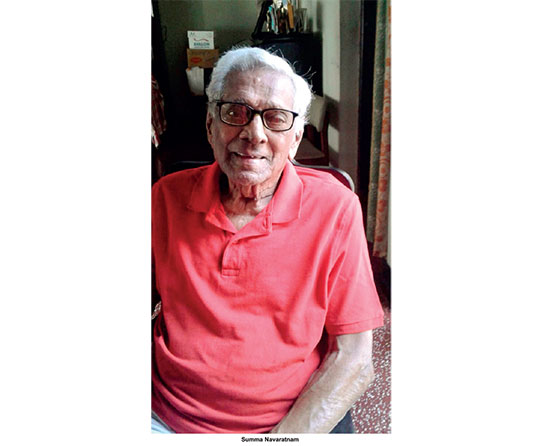
Barrier Breakers
Sumanthiran Navaratnam a.k.a. Summa Navaratnam had a penchant to break records. Being a nonagenarian itself is a record. He is 96 years old and is the oldest living Sri Lankan Athlete. He was born on 21st May 1925.
He is the son of the late S.S. Navaratnam of the former Ceylon Civil Service and K.T Navaratnam nee Ratnam, daughter of Dr. C.S. Ratnam, Provincial Surgeon. His Civil Servant father wanted his son to obtain a Public School education, hence chose Royal College, Colombo for his son to attend.
Summa cut his teeth in athletics at a tender age of 12 years. At a young age of 15 years (1940) he was awarded Royal College athletics colours. To date he is the youngest athlete to achieve this at Royal – another record. In 1939 he became the Champion Junior Athlete at the Royal College Inter-House Athletic meet by winning the Best Performance Award in 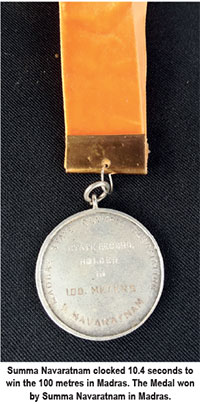 the Under 14 age category and the following year in the Under 16 age category. He won the 200 meters and 400 meters at the Public Schools Athletic meet with excellent timings and was also a member of the 4×100 meters relay winning quartet, all in 1943. He captained the Royal College athletics team in both 1942 and 1943.
the Under 14 age category and the following year in the Under 16 age category. He won the 200 meters and 400 meters at the Public Schools Athletic meet with excellent timings and was also a member of the 4×100 meters relay winning quartet, all in 1943. He captained the Royal College athletics team in both 1942 and 1943.
In 1944, representing the Royal College Old Boys Athletics team at the National Amateur Athletics Association (AAA) Championships, Summa won the sprint double in the 100m and 200m events. He was the national 100m champion in meets held in 1944, 1946 and 1947. He was also awarded the Wilton Bartleet Trophy for the Best Individual Performance in these years. He also won the 100m at the National Championships in 1951. In 1953 he ran the 100 meters with the Asian Champion Lavy Pinto (Goa, India) and they were both timed at 11.0 sec, however Lavy Pinto was determined the winner. Summa also won the 200 meters event at the 1944 and 1946 National Championships.
As an up and coming champion young athlete he was included in the 4×100 meter relay team to compete in the Indo-Ceylon Dual Athletic Meet in 1945. This team included outstanding athletes Duncan White, R.E. Kitto and Basil Henricus.
In 1953 Summa participated in the Madras Provincial Olympic Games. He returned a timing of 10.4 seconds, which was the fastest timing, recorded on a grass track in Asia and was dubbed as the ‘fastest man in Asia’. In this event he beat the Indian National Champion Ivan Jacobs, who was the favorite for the event. Yours truly was an undergraduate at the University of Ceylon, Peradeniya and when we read this in the newspapers at that time, we jumped up in joy. However there were some critiques in the athletic circles; they mentioned that you cannot depend on individual timekeepers, even though this was the official and accepted method of recording at that time even in most of the International Athletic Meets. (Auto timing was used only from the 1952 Olympics.) This was an amazing record and feat for an athlete from Ceylon.
Due to nepotism on part of certain officials he was not selected to represent Ceylon in the 1948 Olympics in London and the 1952 Olympics in Helsinki. At the 1948 London Olympics the winning time of the 100 meters was 10.3 seconds, which was achieved by Harrison Dillard of the USA. Silver medalist Barney Ewell clocked 10.4 seconds and Bronze medalist Lloyd LaBeach of Panama was also timed at 10.4 seconds. At the 1952 Helsinki Olympic Games the 100 meters Gold medalist was Lindy Remigino (USA) was timed at 10.79 seconds, Silver medalist Herbert McKenley (Jamaica) returned 10.8 seconds and Bronze medalist McDonald Bailey (Great Britain) clocked in at 10.83 seconds (all via auto electric timing).
In 1950, Summa had the honor of representing Ceylon at the British Empire Games held in Aukland, New Zealand. He competed in the 100 yards and 4×100 yards events.
In 1953 Summa started his Athletics Coaching career and did it for his alma mater Royal College.
The Ceylon contingent to the 1962 Jakarta Asian Games had five athletes he coached, i.e., Darrel Lieversz (400m), Lakshman de Alwis the school boy athlete from Moratu Vidyalaya, who later became the national champion (100m, 200m), Nirmali Dissanayake (100m, 200m) – she became the first female athlete to win an Asian Games medal for Ceylon, when she won the bronze medal, Lorraine Rutnam (100m, 200m) and Jilska Flamer Caldera (80m Hurdles).
By 1955 Summa decided to retire from competitive Athletics but continued playing Rugby Football for the CR & FC and All Ceylon. If not for the nepotism of certain officials in the athletic administration at that time, Summa would have won greater honor at international athletic meets including the British Empire Games and the Olympics.
He is married to Romaine and they have two children Kendle and Nadine.
We wish Summa a very happy 96th birthday, staying safe and well.
(K.L.F. Wijedasa – Former National Champion and record holder in the 100 metres)
Sports
England face Australia in the battle of champions
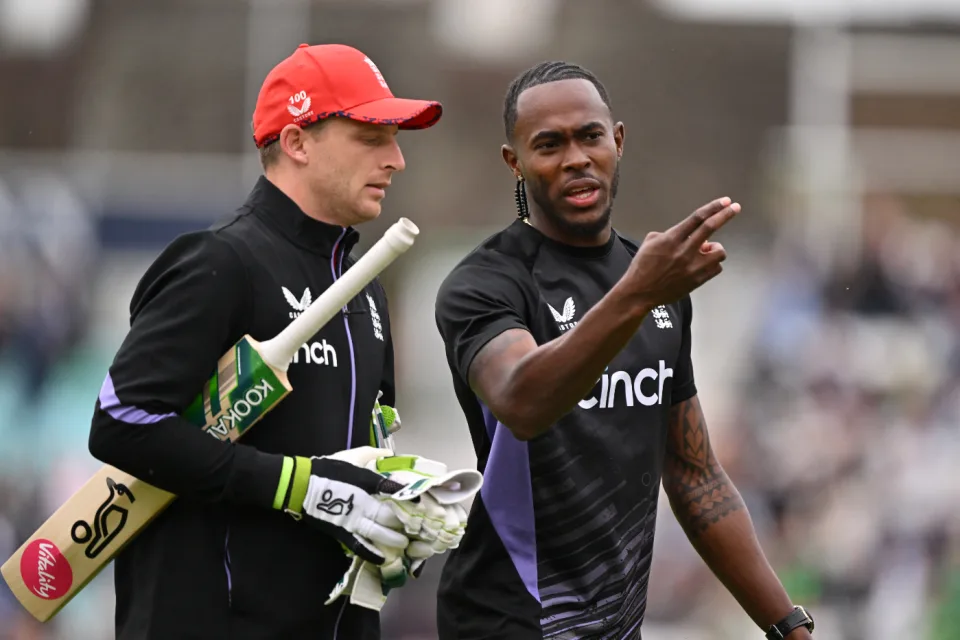
The first truly heavyweight clash of this expanded T20 World Cup format comes freighted with both history and subplots. A rematch of the 2010 World T20 final at Kensington Oval, the match pits Jos Buttler’s defending champions – who are aiming to become the first team to retain the trophy – against the Australian winning machine, victors at the 2021 edition and current world title-holders in Test and ODI cricket. And that’s before you throw in the Ashes for afters.
Already there is added pressure on England, after the rain in Bridgetown led to a share of the points in their opener against Scotland (and that having conceded 90 runs from 10 overs without taking a wicket in a tepid bowling display). Lose to their oldest rivals and it will leave their Super 8 prospects open to being waylaid by the perils of net run-rate calculations, or worse.
The Scotland match was the third abandonment in five suffered by England, after a rain-affected home series against Pakistan, which has clearly hampered their readiness for this campaign after almost six months without playing T20 together. It does not take much for a side to click in this format – and England looked in decent shape when they did get on the field against Pakistan – but Buttler will be anxious for things to go their way on Saturday, if only to avoid further questions referencing the team’s disastrous ODI World Cup defence last year.
Australia, under the laidback leadership of Mitchell Marsh would love nothing more than to add to the English sense of jeopardy – having helped bundle them out of the tournament in India on the way to taking the crown. Their head to head record is less impressive in T20 however, with England having won six of the last seven completed encounters, as well as that 2010 final.
Despite a wobble with the bat, Australia avoided mishap against Oman earlier in the week, the experience of David Warner and Marcus Stoinis shining through in difficult batting conditions. Surfaces in the Caribbean – not to mention those games staged in the USA – have already had teams scratching their heads; rather than the “slug-fest” England had prepared for, following a high-scoring tour of the Caribbean in December, it looks as if boxing smart may be the way to go.
Speaking of Warner, this could be the last time he faces up against England in national colours – and another match-winning contribution would likely reduce the chances of them meeting again in the knockouts. On the other side of the card is Jofra Archer, fresh from an emotional maiden outing at Kensington Oval and ready to take on Australia for the first time in any format since 2020. Can Mark Wood fire up England’s campaign, as he did during last summer’s Ashes? Will Pat Cummins be back to harass the old enemy once again? Seconds out, it’s almost time to rumble.
Cummins is set to return after being rested for the Oman game, which saw Mitchell Starc leave the field with cramp. Starc is understood to be fine and could keep his place – which would likely see Nathan Ellis miss out. Marsh is still not fit to bowl, with Australia likely to continue with the allrounder combination of Stoinis and Maxwell to give them cover.
Australia (probable XI): David Warner, Travis Head, Mitchell Marsh (capt), Glenn Maxwell, Marcus Stoinis, Josh Inglis (wk), Tim David, Pat Cummins, Nathan Ellis/Mitchell Starc, Adam Zampa, Josh Hazlewood
The one change England may consider is Reece Topley coming in for Wood, with the expectation that there will be some rotation among the seamers through the course of the tournament.
England (probable XI): Phil Salt, Jos Buttler (capt & wk), Will Jacks, Jonny Bairstow, Harry Brook, Liam Livingstone, Moeen Ali, Chris Jordan, Jofra Archer, Adil Rashid, Reece Topley/Mark Wood
[Cricinfo]
Sports
South Africa up against their bogey team in batter-unfriendly New York
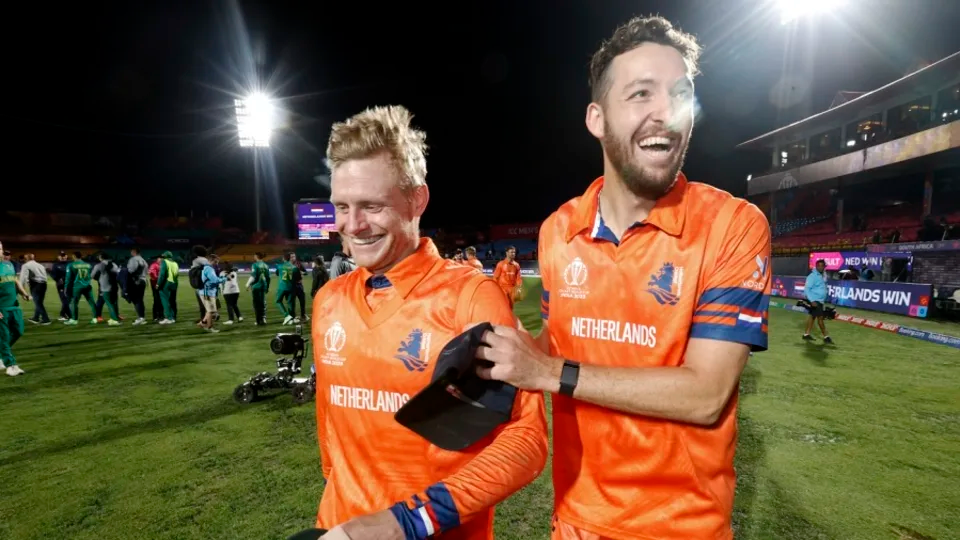
Once is coincidence, twice is a clue, and three times is proof.
To paraphrase Agatha Christie, that is the narrative around South Africa’s meeting with Netherlands at this T20 World Cup.
The Dutch beat South Africa at the 2022 tournament and ended their semi-final hopes in a match where South Africa appeared to be sleep walking, and then beat them again at the 2023 ODI World Cup, where they exposed South Africa’s vulnerability in the chase. If they to do the treble, not only will Netherlands take the lead in Group D, but they will offer conclusive evidence of the threat they pose to Full Members, especially South Africa.
Of course, it will take some doing after South Africa’s opening performance against Sri Lanka, where they reduced their opposition to their lowest T20I total and chased it down in fairly straightforward fashion thanks to the most stable middle-order of their white-ball era. In Aiden Markram, Tristan Stubbs, Heinrich Klaasen and David Miller, South Africa have bankers and big-hitters and, for this match, they also have the advantage of experience. They’ve already played at Eisenhower Park, and have first-hand knowledge that run-scoring doesn’t come easily;Klassen said they are prepared to use their “cricket brains” and play “smarter cricket”.
But the conditions could be good news for Netherlands, who are not naturally a line-up of big hitters and build their innings on a foundation of turning ones into twos. In other words, they tend to take a slightly more conservative approach to batting, which may work well here, but they’ll be wary of the uneven bounce of the surface and will have to come up with plans to counterattack especially against South Africa’s seamers. Their own bowlers were exemplary in Dallas and will look to build on that performance against a line-up that will likely be more proactive than Nepal’s, but who they have managed to keep quiet not once, but twice in the past. Third time’s the charm, they say.
Anrich Nortje’s stunning return to form against Sri Lanka means South Africa may not have to tinker with the bowling combination, and Gerald Coetzee and Tabraiz Shamsi may have to wait their turns to get a game. The batting line-up should be unchanged, with no space for Ryan Rickelton yet.
South Africa: Quinton de Kock (wk), Reeza Hendricks, Aiden Markam, Tristan Stubbs, Heinrich Klaasen (wk), David Miller, Marco Jansen, Keshav Maharaj, Kagiso Rabada, Ottneil Baartman, Anrich Nortje
Conditions in New York may tempt Netherlands to include an extra seamer and they have Kyle Klein in their squad. But it could come at the expense of a shortened batting line-up and they may not want to risk that.
Netherlands: Michael Levitt, Max O’Dowd, Vikramjit Singh, Sybrand Engelbrecht, Scott Edwards (capt, wk), Bas de Leede, Teja Nidamanuru, Logan van Beek, Tim Pringle, Paul van Meekeren, Vivian Kingma
[Cricinfo]
Latest News
Mustafizur, Rishad, Hridoy dazzle in Bangladesh’s tight two-wicket win over Sri Lanka
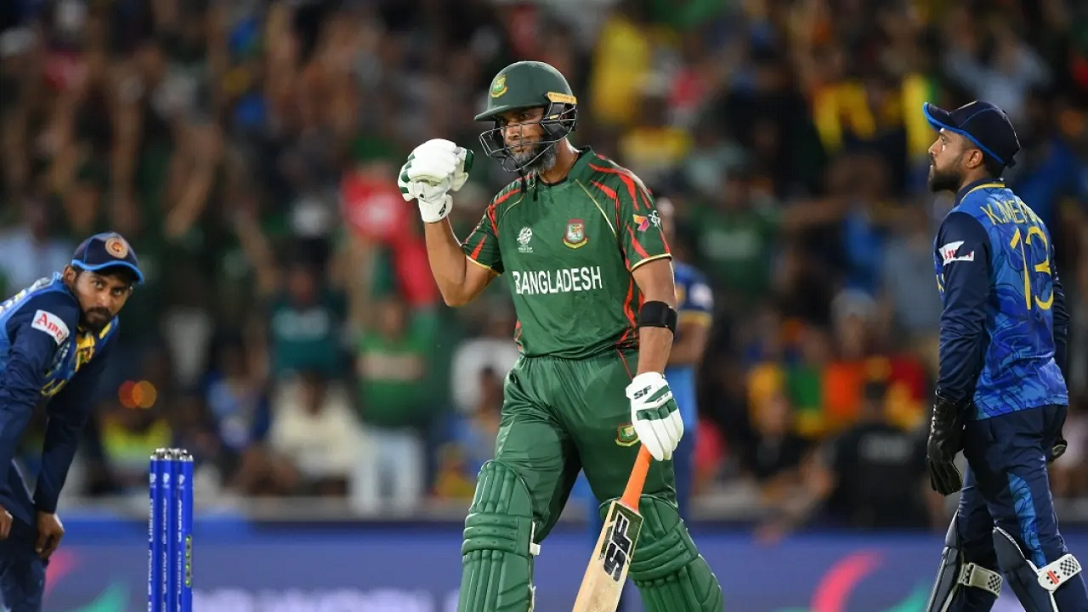
Nuwan Thushara’s last over brought Sri Lanka screaming back into the match,as he first bowled Rishad Hossain, and then nailed Taskin Ahmed in front of the stumps with a pinpoint swinging yorker. This left Bangladesh eight wickets down, with 12 runs still to get.
However, the experienced Mahmudullah was at the crease for Bangladesh, and despite some further nervy moments, pushed Bangladesh across the line off the last ball of the 19th over.
But this was a match chiefly decided by Bangladesh’s own outstanding bowling. Mustafizur Rahman was the best among them, using shorter lengths and his cutters efficiently, to claim figures of 3 for 17. Rishad Hossain’s three-for through the middle overs also kept Sri Lanka quiet.
Mustafizur was instrumental in Sri Lanka’s downward spiral through the middle overs, which culminated in a crash-and-burn end. Ultimately, their inability to find boundaries, or even rotate strike against good Bangladesh bowling resulted in their downfall. A score of 125 for 9 always seemed poor on a decent pitch, even if their bowlers made a match of it in the end.
Brief scores:
Bangladesh 125 for 8 in 19 overs (Towhid Hridoy 40, Litton Das 36; Dhanajaya de Silva 1-11, Nuwan Thushara 4-18, Wanidu Hasaranga 2-32, Matheesha Pathirana 1-27) beat Sri Lanka124 for 9 in 20 overs (Pathum Nissanka 47, Dhananjaya de Silva 21; Tanzim Hasan Sakib 1-24, Taskin Ahmed 2-25, Mustafizur Rahman 3-17, Rishad Hossain 3-22) by two wickets
[Cricinfo]












